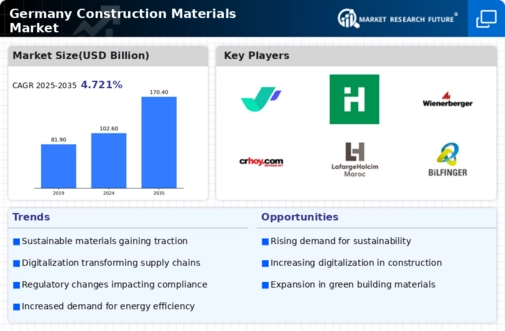The construction materials market in Germany is characterized by a competitive landscape that is both dynamic and multifaceted. Key growth drivers include the increasing demand for sustainable building practices, urbanization, and infrastructure development. Major players such as HeidelbergCement AG (DE), Knauf Gips KG (DE), and BASF SE (DE) are strategically positioned to leverage these trends. HeidelbergCement AG (DE) focuses on innovation in low-carbon cement solutions, while Knauf Gips KG (DE) emphasizes product diversification and sustainability in gypsum-based materials. BASF SE (DE) is enhancing its portfolio through digital transformation and advanced material technologies. Collectively, these strategies not only enhance their market presence but also shape a competitive environment that prioritizes sustainability and innovation.
In terms of business tactics, companies are increasingly localizing manufacturing to reduce transportation costs and enhance supply chain efficiency. The market structure appears moderately fragmented, with a mix of large multinational corporations and smaller regional players. This fragmentation allows for a diverse range of products and services, fostering competition among key players who are vying for market share through strategic initiatives.
In November 2025, HeidelbergCement AG (DE) announced a partnership with a leading technology firm to develop AI-driven solutions for optimizing production processes. This strategic move is likely to enhance operational efficiency and reduce costs, positioning the company favorably in a market that increasingly values technological integration. The collaboration may also facilitate the development of innovative products that meet the evolving demands of environmentally conscious consumers.
In October 2025, Knauf Gips KG (DE) launched a new line of eco-friendly insulation materials aimed at reducing energy consumption in buildings. This initiative underscores the company's commitment to sustainability and aligns with the growing regulatory pressures for energy-efficient construction. By introducing such products, Knauf Gips KG (DE) not only addresses market demand but also strengthens its competitive edge in a sector that is progressively leaning towards green building solutions.
In September 2025, BASF SE (DE) expanded its research and development capabilities by opening a new innovation center focused on sustainable construction materials. This expansion is indicative of the company's long-term strategy to lead in the development of advanced materials that meet stringent environmental standards. The investment in R&D is expected to yield significant returns as the market shifts towards more sustainable practices, thereby enhancing BASF's competitive positioning.
As of December 2025, current competitive trends in the construction materials market are heavily influenced by digitalization, sustainability, and the integration of AI technologies. Strategic alliances among key players are shaping the landscape, fostering innovation and enhancing supply chain reliability. The shift from price-based competition to a focus on technological advancement and sustainable practices is becoming increasingly evident. Companies that prioritize innovation and adaptability are likely to thrive in this evolving market, as they respond to the growing demand for sustainable and efficient construction solutions.





















Leave a Comment